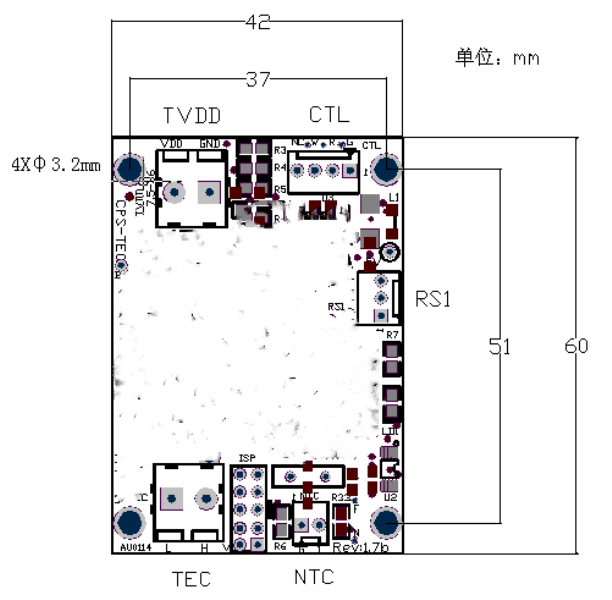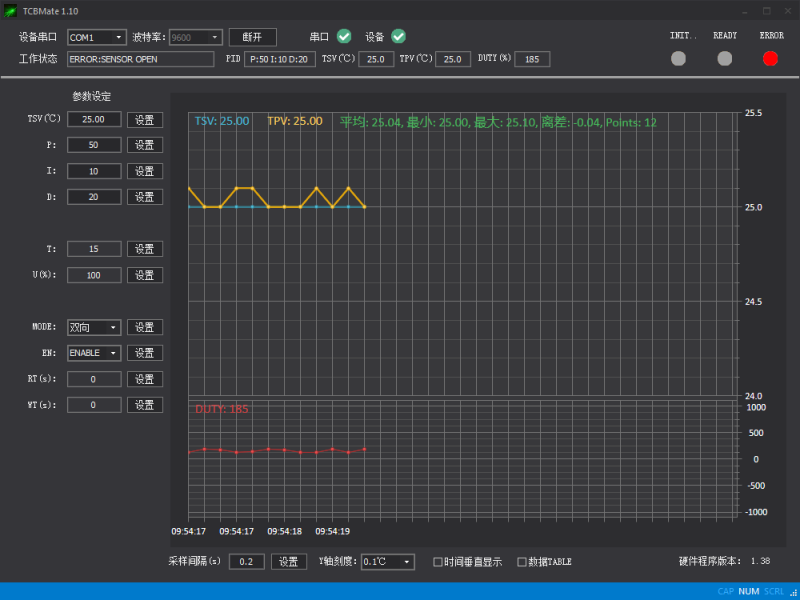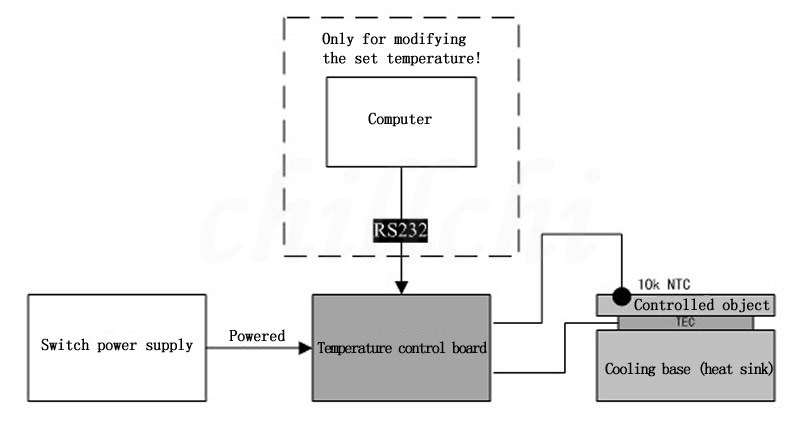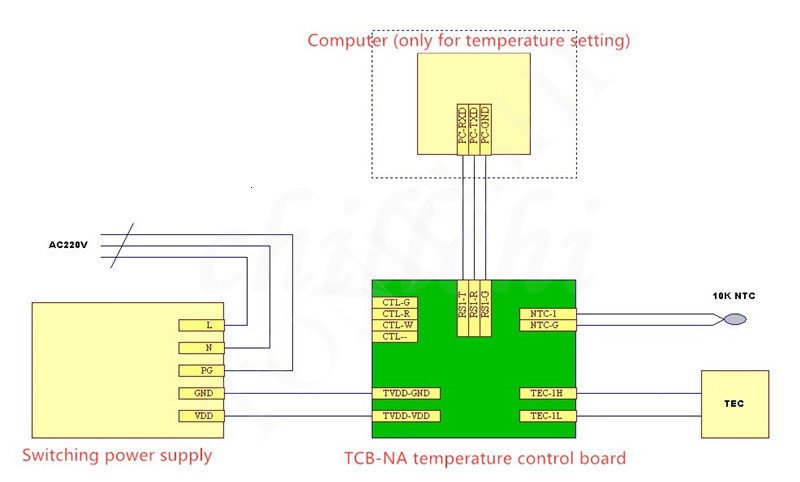Condition:New
Type:Logic ICs
About TEC temperature control:
TEC: Also called semiconductor refrigeration film, or thermoelectric refrigeration film, which uses the Peltier effect, that is, when the direct current flows through a couple of two different semiconductor materials in series in different directions, the generated heat flows in one direction Effect, which can achieve the purpose of cooling or heating, and made a semiconductor chip device.
TEC temperature control board: Use DC power supply, TEC as the temperature control element, use a temperature probe to detect the temperature of the controlled object, the temperature control board uses PID algorithm to adjust the size and direction of the current provided to the TEC element in real time, so as to achieve the purpose of constant temperature.
High stability (+-0.01), universal TEC temperature control, long-term verification in the laser field.
Two-way temperature control, automatic switching between heating and cooling, supporting various types of TEC; can also be set to one-way mode, supporting one-way devices such as resistance wires and ceramic heating rods.
For temperature probe, the standard version supports 10K NTC by default, and PT100/PT1000 versions are available for selection.
Can run independently. Parameter viewing and setting can be connected to the display screen, or other single-chip serial port control, or use universal serial port software, or special host computer software.
Support multi-channel control, with specific documentation.
Accessories: plugs and ferrules for board docking; NTC version comes with a 10K NTC by default, the same specifications as shop NTC.
model:TCB-NC (TCB-NE reduced version)
The board model that uses NTC (10K) sensor is:TCB-NC; The model using PT100 isTCB-NC-PT100, The model using PT1000 isTCB-NC-PT1000.NTC, PT100 and PT1000 are different temperature sensors. NTC is the default and recommended, which is cheap and easy to use. PT can be used in a wide temperature range due to its wide temperature range.
Temperature control board selection table:
Temperature control board model
|
stability
|
TEC drive capability
|
Supply voltage (V)
|
Size(mm)
|
Features
|
Model
|
TCB-NE
|
0.01
|
10A@24V /12A@12V
|
5-24
|
75*65
|
Generic version
|
TCB-NE
|
TCB-NE-AH
|
0.01
|
18A@24V /24A@12V
|
7-24
|
95*65
|
General version, enhanced power
|
NE-AH
|
TCB-NC
|
0.01
|
10A@24V /12A@12V
|
5-24
|
60*42
|
NE reduced version
|
TCB-NC
|
TCB-NA
|
0.1
|
12A@24V /15A@12V
|
5-24
|
60*42
|
NC simplified version
|
TCB-NA
|
TCB-SV
|
0.01
|
4.5V2.5A
|
7-24
|
60*42
|
Suitable for small TEC
|
TCB-SV
|
TCB-SA
|
0.01
|
4.5V3A
|
5
|
60*42
|
Suitable for small TEC
|
TCB-SA
|
TCB-SS
|
0.01
|
4.5V3A
|
5
|
40*40
|
SA reduced version
|
TCB-SS
|
Our DivisionTECThe temperature control board is specially designed for the temperature control system using TEC, and adopts an innovative design scheme, High reliability, supportTECVoltageAnd currentwide range.Temperature control stability is +-0.01degree! Use the serial port to directly modify the set temperature or call information. With alarm ready interface. This board has been widely used in the laser field for a long time.This board is suitable for occasions that require high-precision temperature control and high TEC power.
Features:
Digital integral separationPIDAlgorithm, parameter and period adjustable
0.01 high precision temperature control, +-0.01° stability
No need for additional heat dissipation measures, no need for heat dissipation bottom plate
High-precision voltage reference, temperature measurement accuracy is guaranteed to be +-0.25°, full range +-0.5°, and can be corrected
Board power supply voltage:5V- 24V
TECGreat voltage range: 2V~24V
TECLarge current range:10A (24V power supply), 12A (12V power supply)
Support two 12706 in parallel, or two 12710 in series!
Two-way control, support heating and cooling (Can be configured as single heating or single cooling through communication protocol)
Single heating mode supports heating elements such as ceramics and resistance wires
The temperature can be set and detected through the serial port (ASCIICode agreement, provide guidance documents)
With alarm, ready signal output, yesDISABLE TECOutput
Control method: continuous voltage, The best way
Recommended Applications
The temperature control element isTEC(Semiconductor cooler, thermoelectric cooler)Temperature control system
Suitable for, but not limited to, temperature control of laser diodes
Applicable to various fields such as industry and home appliances
Parameters Table
Board power supply voltage:5- 24V(Recommended standard voltages such as 5/7.5/12/15/24. The TEC rated voltage is preferably equal to or slightly greater than the supply voltage. If the TEC rated voltage is less than the voltage voltage, it is also possible. Set the maximum output ratio.)
TECVoltage: 2V 24V
TECCurrent:10A (24V power supply), 12A (12V power supply)
Temperature Sensor:10K NTC(BValue default3950,actualBThe value can be unlimited, only affects the absolute temperature, does not affect the relatively stable temperature, and is basically meaningless for temperature control. When the B value is 3950, the initial error of the probe itself is not considered, and the absolute measurement error is within 0.1)
Temperature control resolution:0.01°
Set temperature resolution:0.01°
Stability: +-0.01°
NTC version temperature measurement range: -60° ~ +170°
NTC version control temperature range: -20° ~ +100°
PT version temperature measurement range: -60° ~ +212°
PT version control temperature range: -50° ~ +200°
Dimensions:60mm*42mmheight23mm(On board18.5mm, Board thickness1.5mm, Under-board pins3mm)
Board control method:
This board uses serial communication to modify and monitor information. There are specific control methods as follows:
1. Our dedicated display DISP-TCB(Connect the serial port of the temperature control board to the display)display sell in our store.
2. Our dedicated PC software TCBMate(Connect the serial port of the temperature control board to the computer)
3. Directly use the serial port to send commands to control (support single-chip, or PC), see the communication protocol section of the manual

?System diagram:
As shown in the figure below, to form a complete temperature control system, in addition to the temperature control board, you also need to select the appropriate TEC according to the actual needs of the project (there are many TEC models, different brands, different sizes, and different currents and voltages), and appropriate switches are also required The power supply supplies DC power to the board, and a temperature probe is also required. If it is an NTC version of the temperature control board, our company will attach a 10K NTC probe by default. If it is a PT version, the customer must purchase it by himself. Then, according to different methods of viewing and modifying parameters, a suitable serial port cable may be required. There are instructions on the serial port in our application materials.

Signal connection diagram:
As shown in the figure below, the connection method of the temperature control board of our company is similar, that is, connect the probe (the probe has no direction on the two feet), connect the TEC (the TEC has a direction, and the connection method is explained on the explanation), connect the power supply line, pay attention to the power supply The line must not be reversed! Connect the serial port control line.

Othe note:
1. About TEC
When considering the current-voltage relationship of TEC, TEC can be simply understood as a resistor, such as a 12V6A TEC, which can be regarded as a 2 ohm resistor. Then give this TEC 6V drive voltage, its output current is 3A. Limiting the maximum current of the TEC is the same as limiting the maximum voltage. Limiting the maximum driving voltage of the board to the TEC is also equivalent to limiting the maximum current of the TEC. The board has the SU instruction to limit the maximum output voltage (except TCB-NA). TEC can work in parallel or in series. For example, two 12V/4A TECs become 24V/4A in series, and 12V/8A in parallel.
2. About the temperature sensor
The default temperature sensor used by our temperature control board is: Thermistor (10k NTC, B value 3950). Some boards support the selection of another commonly used temperature sensor: thermal resistance (PT100 or PT1000). If it is thermal resistance, our board adopts two-wire measurement method.
The thermistor and thermal resistance have no difference in accuracy. The accuracy is determined by the measurement circuit, not by the sensor. It is generally recommended to use NTC. NTC has the advantages of small package, many types and manufacturers, cheap and easy to use. The advantage of PT100/PT1000 is that it has a wide range of temperature measurement and control.
3. Call information about serial port, set temperature, monitor temperature
If you use a computer to view and set the parameters, you need to make a serial cable (available in our shop) to connect to the computer. If your computer does not have a serial port, you need to buy another USB to serial cable. For details, please refer to the description of the document <<Serial Communication Guidelines>>.
4. About the interface
The manual has detailed interface definitions. The board interface uses 2510 terminals. The manufacturer will provide plugs and ferrules, and no additional purchase is required.
5. About stability
The stability of temperature control, such as +-0.01, that is, the temperature of the controlled object in the normal system can be stabilized within +-0.01 of the set value. Generally speaking, for temperature control systems, the most important parameter is stability.
But note that people who have no practical experience in temperature control applications may have deviations in their understanding of stability!
The temperature control boards of our company have been tested on our load, and the marked accuracy parameters can be confirmed to be achieved, such as +-0.01 stability! Note, however, that the nominal rating can be achieved, which does not mean that the customer can simply build a system to achieve it! Because temperature control is a system, the temperature control board is only one of them. For example, the installation method of the probe has a great influence on the temperature control effect. For details, please see the instructions on the product manual and the application data. Another example is the temperature control range, the nominal range of the board, which means the range supported by the board's algorithm, not that it can be achieved with this board. For example, the board's nominal minimum can be controlled to -20 degrees. If the user's TEC power is not enough, or the object design has other problems, such as poor heat dissipation, let alone -20, even 0 degrees may not be reached.
6. Regarding temperature accuracy
Accuracy represents the error between the current measured temperature and the absolute true temperature in a physical sense. For general systems, this value is not important, because for example, the currently measured measured temperature is 25 degrees, and the absolute true temperature is 24.5 If the object is stable at the measured temperature of 25 degrees, the object is also stable at the true temperature of 24.5 degrees. This is enough for a general system. As for the current real temperature, it does not matter (for example, for laser applications, it is necessary to adjust to find an optimal temperature to obtain the best output). However, if the temperature measurement accuracy is high, it is also beneficial. One is that some applications may require high accuracy (for example, to achieve a certain temperature scene to measure other characteristics of the object), the other is high The accuracy can realize the interchangeability of the boards, that is, for the same controlled object, even if the temperature control board is changed, as long as it is set to the original setting value, there is no need to find an optimal temperature again. If the customer has requirements for accuracy, if the accuracy of the board itself cannot meet the customer's requirements, you can calibrate to meet specific needs according to the calibration and accuracy assurance methods provided by our company.

